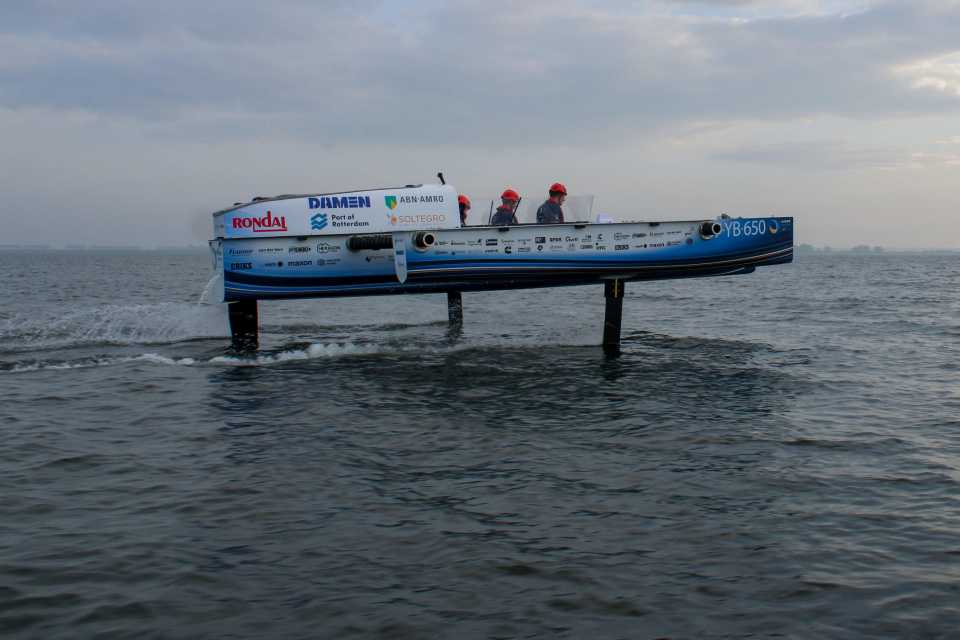The TU Delft Solar Boat Team has realised the first “flying” hydrogen boat with their project Hydro Motion. The trimaran design weighs over 1000 kilogrammes. At a speed of 22 kilometres per hour, the hydrofoils lift the boat from the water while being powered by hydrogen.
The goal of the Hydro Motion project was to create a seaworthy boat, fully equipped with a hydrogen system and wings under the boat. Now that the design, production and test period has been concluded, the student team will compete in the World Championships from 8 to 10 July on the open sea in Monaco. The students will be going for the win in the long-distance race and will be competing against other sustainably powered boats. With this they want to demonstrate the potential of hydrogen-powered boats.
Focus on endurance
The twenty students completed the boat within one year. ‘It worked, we can say that with certainty,’ says Rick van Wilsem, chief engineer. ‘The entire boat has come out of the water. We are proud to announce with the team that we have made the world’s first foiling hydrogen boat.’
The TU Delft (Delft University of Technology) team will compete against opponents from all over the world, students but also companies. Electric and hydrogen-powered boats will compete against each other in three race sections: manoeuvrability, sprint and endurance. The team has set its sights on the latter race. The hydrogen-powered boat has been optimised to take on the challenge of travelling six hours on the open sea without refuelling. The team that covers the most distance is the winner.
The race can be followed through the website and the social media channels of the TU Delft Solar Boat Team. The team is now busy with the final preparations for the world championships in Monaco. For example, a race simulation is being performed, in which everyone can prepare his or her role for the race.
Also read: Even without wings TU Delft Solar Boat wins World Championships
The Hydro Motion hydrogen boat
The boat that the team has been working on this year is an impressive sight: a seaworthy trimaran, more than eight metres long, equipped with a complete hydrogen system, the smartest electronics, all the components to propel the boat powerfully and the strongest hydrogen wings. The boat is piloted by three pilots and reaches speeds of up to forty kilometres per hour. In the students’ boat, hydrogen gas is stored under high pressure in an on-board tank. The fuel cell combines this hydrogen with oxygen from the air to generate electricity. This powers the engine.
But how does this enormous hydrogen boat get into the air? Three super strong hydrogen wings are attached underneath the boat. These work under the water surface in a similar way to the wings of an aeroplane. At a take-off speed of 22 kilometres per hour, they lift the weight some forty centimetres above the waves. When the hulls of the boat fly above the water, they experience drastically less resistance than in the water. In this way, the boat uses very little energy. Efficiency is of great importance during the challenging long-distance race that awaits the team in Monaco.
From solar to hydrogen
The TU Delft Solar Boat Team is a multidisciplinary team consisting of twenty students. They all put their studies aside for a year for the Hydro Motion project. They want to inspire the maritime industry, currently a large consumer of fossil fuels, towards a green future.
Previously, the team made solar boats, as the name implies. After fifteen years, a big step has been taken with the transition to hydrogen. With the help of alumni and partner companies, they switched from generating green energy to storing it. The ability to store green energy on board is an essential step towards making shipping greener. Especially for larger ships and long distances, there is a need for a medium that can store a lot of green energy in little volume. Hydrogen is a good option for this.








